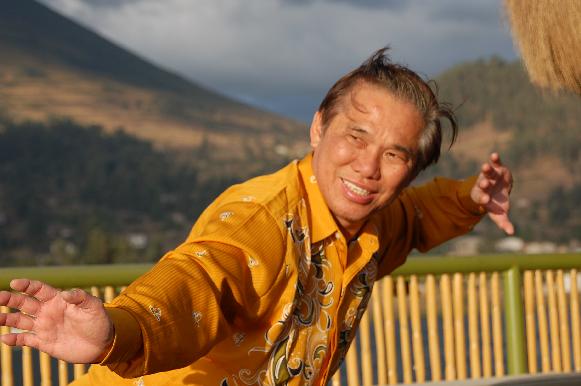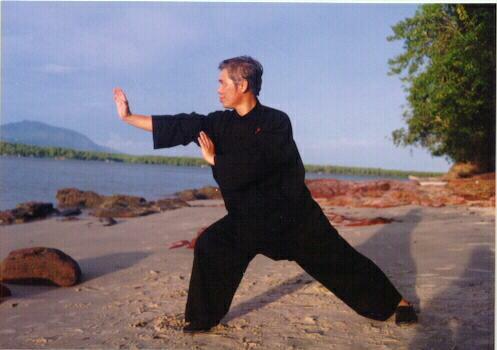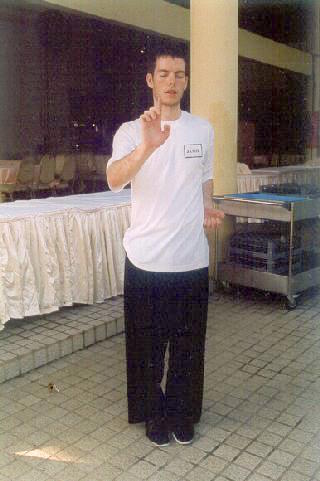November 2006 (Part 1)
SELECTION OF QUESTIONS AND ANSWERS

Sifu Wong performing some Cloud Hand movements while on board a boat in Ecuador
Question 1
In one of your answers on your web page you mention 3 arts that were described as "ultimate" by old time martial artists: One-Finger Zen, Striking Across Space Palm, and Shaolin Marvelous Fist. Could you please describe them?
— Jeff, USA
Answer
These three arts were described as “Mo Lam Sam Chuit” (Cantonese pronunciation), meaning “the three ultimates in the world of martial arts.” Incidentally, they are all from Shaolin Kungfu. All these arts can injure an opponent without physical oontact.
A master of “One-Finger Zen”, or “Yeit Chi Sim”, can injure an opponent by “dotting” his vital points within thirty six steps. The main training method is “One-Finger Shooting Zen”.
A master of “Strike-Across-Space Palm”, or “Phet Hung Cheong”, can injure an opponent with a palm strike within seventy two steps. The main training method is “Cosmos Palm”.
A master of “Shaolin Marvelous Fist”, or “Siu Lam Shen Khuen”, can injure an opponent with a punch within a hundred and eight steps. The main training method is “Striking a Well”.
One may think that as “Shaolin Marvelous Fist” can cause injury from the longest distance, it is the most advanced of the three. But traditionally “One-Finger Zen” is considered the most advanced, and “Strike-Across-Space Palm” the next. It is because striking with a finger demands the highest level of control and focus.
Moreover it also can be used for healing. “Striking-Across-Space Palm” can be used for healing too, but it is not as sphofisticated as “one-Finger Zen”. “Shaolin Marvelous Fist” is only used for damaging.
Is attaining these skills the supreme achievement in martial art training? As in many other things in life, the answer is yes and no. If we consider only combat efficiency, the answer is yes. While they are not absolutely invincible, it is extremely difficult for an opponent to escape injury from a master of these arts.
But defeating opponents is not the highest attainment in great kungfu. The supreme achievement is Zen, called variously as merging with the Tao or return to God. Using these arts for destruction is contrary to such supreme spiritual cultivation.
We may use these arts for healing. The tremendous internal force needed for destruction in these arts can also be used beneficially for healing others as well as promoting vitality and longevity for ourselves. The internal force can also open their heart, making them happy and free.
Yet, these benefits are still in the phenomenal realm. If we want to aspire to the highest, we have to transcend the phenomenal. Zen meditation, practicing while sitting in a lotus position or in any other positions including in combat application, is the royal path — when we are ready.
Most people, of course, are not ready yet. Hence, speaking relatively for their present needs, these arts may be regarded as the ultimate if they also apply them for wholesome purposes like attaining good health, vitality, longevity and happiness, and not just for hurting their opponents.
Question 2
Did Yang Lu Chan, Yang Jian Hou and Yang Ban Hou practice Chen Style Tai Chi Chuan, or did Yang Lu Chan create Yang Style?. Didn't what the world now knows as Yang Style Tai Chi Chuan come from modifications that Yang Deng Fu made to the Chen Style that his father (Yang Jian Hou) practiced?
— Jason, USA
Answer
I believe Yang Lu Chan and his two sons, Yang Jian Hou and Yang Ban Hou, practiced Chen Style Tai Chi Chuan. Yang Jian Hou's son, Yang Deng Fu, initially practiced Chen Style too, but later he modified many of his Tai Chi Chuan patterns, especially making their movements slower and bigger.
These modifications were made to enable beginning students to learn more easily, and also for health purposes. Yang Deng Fu believed that by making the Tai Chi Chuan movements bigger and slower, students could have better health benefits. The smaller, faster movements were more suitable for combat. (But this does not mean that big movements do not have combat functions.)
Hence, students began with slow and big movements. These were referred to as “Big Forms”. When the practitioners were advanced, the movements were reduced in size and performed with faster speed. They were referred to as “Small Forms”.
This modified version of Tai Chi Chuan came to be known as Yang Style. For some reasons which have not been adequately clarified, Yang Style Tai Chi Chuan is generally regarded as invented by Yang Lu Chan instead of by Yang Deng Fu, which is more appropriate. Perhaps this is because the evolution of Yang Style from Chen Style was gradual, without any announcement formally made. Hence people associated the new style with Yang Lu Chan who brought the once exclusive Tai Chi Chuan out from the Chen Village.
Question 3
What style of Tai Chi Chuan does Sifu Wong practice?
Answer
I practice Wahnam Tai Chi Chuan. It was influenced and inspired by Yang Style and Chen Style.
Initially we did not identify our Tai Chi Chuan by a specific name. We just called it Tai Chi Chuan. But later, to avoid wasting time to respond to hostile criticisms that we should not associate ours with Yang Style or Chen Style because we did not have direct lineage in these two styles, some of my disciples suggested that we named our style Wahnam Tai Chi Chuan.
This freed us from unnecessary arguments over lineage. It also enabled us to do what we liked with our own style without getting involved in any politics with other styles.

Sifu Wong performing a Wahanm Taijiquan pattern called “Fierce Dragon Across Stream” which is similar to the Chen Style pattern “Lazy to Roll up Sleeves”
Question 4
In Sifu Wong's “Complete Book of Tai Chi Chuan”, “Grasping Sparrow's Tail” does not appear in the Wudang nor the Chen Style descriptions. Did Yang Lu Chan create this pattern?
Answer
I don't think Yang Lu Chan practiced “Grasping Sparrow's Tail”. What he practiced were “Cloud Hands” and “Lazy to Roll up Sleeves” (which we call “Fierce Dragon Across Stream” in Wahnam Taijiquan).
These two patterns were found in Chen Style. In Wudang Tai Chi Chuan they were called “Beginning Cosmos” and “Receiving Wind through Sleeves”.
Later, Yang Deng Fu stylized these two patterns into “Grasping Sparrow's Tail” in Yang Style Tai Chi Chuan. The name “Cloud Hands” was also retained for the pattern where the practitioner's hands moved in circles.
Some records state that Yang Lu Chan practiced “Grasping Sparrow's Tail” thousands of times everyday, and he used only this pattern to defeat all challengers. The facts were true, but the name of the pattern was given in historical hindsight. What we call “Grasping Sparrow's Tail” now was called “Cloud Hands” and “Lazy to Roll up Sleeves” then. There might also be some differences in the exact movements, but the general appearance of the movements resembled today's “Grasping Sparrow's Tail”.
I believe that during Yang Lu Chan's time and before, “Cloud Hands” was a generic name. It referred to movements of the hands in continuous flowing circular actions, often poetically described as “flowing water and floating clouds”.
Question 5
I have been a practitioner of Buddhist Tantra for many years and spent many years in solitary retreats. So that implies a lot of visualization work and sitting meditation. I've also been practicing chi-gong with a Western teacher for several months now.
— Marie, France
Answer
Both Tantra cultivation and visualization work in sitting meditation are very powerful exercises. They should be practiced under the supervision of a competent teacher. It is inadvisable to practice such advanced arts on your own.
You seemed to think that just because you had practiced Buddhist Tantra and had spent many years in retreats, you could employ visualization and practiced sitting meditation correctly. If you had done these two practices wrongly, you would have derived a lot of harm. And the more years you had practiced wrongly, the more harm you would have brought to yourself.
Question 6
My problem is this: due to intensive practice, the dan tian (the navel chakra), has started to produce a lot of heat, like a hot liquid. I gather that this heat is meant to go up the central channel (zhong mai) to the crown. But in my case, I was told that that meridian is blocked and it is therefore like having lit a fire without having a chimney.
Answer
Different arts have different methods and results. In yoga, the energy from your base chakra goes up the central channel to produce kundalini with wonderful health benefits and spiritual awakening. In chi kung, the energy goes up the “du mai” (governing meridian) and then comes down the “ren mai” (conceptual meridian) with similar wonderful results.
The central channel runs from near the anus upwards through the middle of the body to the crown of the head. It corresponds to the “chong mai” (rush meridian) in chi kung paradigm.
The “du mai” runs from the tip of the backbone up the back of the body to the crown of the head and then down the front of the face to the mid-point just above the upper lip. The “ren mai” runs from the mid-point just below the lower lip down the front part of the body to just before the anus. A break-through of chi flow along the “du mai” and the “ren mai” is called “small universal chi flow”, or “micro-cosmic flow”.
As kundalini involves energy flowing upward along the middle channel, whereas small universal chi flow involves energy flowing round the body, asking which route is correct, implying the other route is wrong, is irrelevant because both are correct. It is like asking whether the route up Mount Everest from Nepal or the one from Tibet is correct.
Nevertheless, if either method is practiced wrongly, severe harmful side effects may result. Having a lot of energy blocked, as in your case, is an indication of you having practiced the art wrongly. You should see a yoga master or a chi kung master personally to ask him help you to overcome your problem.

Sifu Jamie Robson performing the Shaolin pattern “One Finger Shooting Zen” in a standing position.
Question 7
That liquid fire gathers in my back along the spine, and it is ever so painful. But because of the chi-gong (I simply do the Shi Ba Shi form and some Chan Mi), it seems to have spread along several meridians in my body - the bladder meridian in the back thigh, the liver or triple warmer, the large intestine meridian. Some points are also throbbing and hot - the yong quan (underfoot), the tai zhong (liver), etc.
This condition, needless to say, is extremely painful and even though I have quit all form of practice, the fire doesn't abate. I'm being treated with herbs and acupuncture, but there's not much improvement. One Chinese doctor said that the chi has escaped from the dan tian and it should not be spread like that and I should be guided properly.
Answer
You symptoms suggest that you have practiced wrongly. The side-effects are serious, but a good chi kung master should be able to help you overcome the problem. You must see a good chi kung master, not just any chi kung instructor.
A good herbalist or a good acupuncturist can also help you to recover, but the result is usually slower than using chi kung.
The Chinese doctor was right. You chi has escaped from your dan tian and has spread wildly. In classical chi kung terms, yours is a case of “fire escaping, evil entering”, which means your vital energy has been dispersed resulting in severe pain and illness.
Your mentioning that you simply did Shi Ba Shi and Chan Mi, is telling. It suggests that you and the teacher who teaches you these two chi kung forms know little about chi kung. Shi Ba Shi (Eighteen Techniques) is an elementary chi kung form whereas Chan Mi (Zen-Tantra) is very advanced. Practicing them together is like riding a bicycle and driving a sport car.
Question 8
I'm requesting some specific instructions to either stop that fire from the dan tian or channel it properly or remove it from the meridians and organs or expel it from the body. I'm at a loss as what to do and request advice urgently. This is a serious condition, I gather. I'm a serious practitioner and will conform to instructions.
Answer
You wrote as if it was very easy for an untrained person to overcome a serious problem by merely acting on instructions from an e-mail or a webpage. You also wrote as if a master must supply you the instructions whenever you asked for it.
Hence, it is unlikely that you are a serious practitioner. A serious practitioner of Buddhist Tantra would know that personal transmission, and not learning from books or e-mails, is crucial. He would also know that being respectful to the master is essential if he ever wants instruction.
You are certainly in a serious condition. You should seek expert help in person.
LINKS
Selected Reading
- Basic Shaolin Combat Sequences
- General Practice and Training, and Sparring Methodology — Zhang Wuji
- Experiencing Satori on the Blue Mountain — Sifu Laura Ferandez
- Learning the Tiger-Crane Set
- Free Sparring with Partner of Another Style
